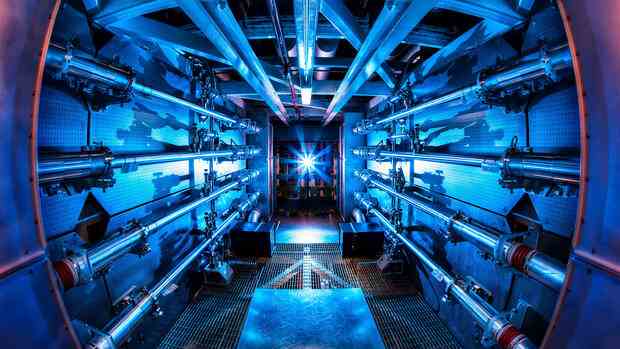new York The success of US researchers in nuclear fusion is not only celebrated as a breakthrough in science. The situation has also changed for the private companies working on the technology. “We are now viewed in a completely different way: Investor interest is increasing,” reports Michl Binderbauer, head of TAE Technologies.
The company from near Los Angeles conducts private research on nuclear fusion and has well-known sponsors such as Google and Chevron. According to the latest news, the Austrian physicist has already made several phone calls to other potential investors.
On Tuesday, US Secretary of Energy Jennifer Granholm, along with the National Ignition Facility (NIF) at the Lawrence Livermore Laboratory in California, announced that researchers had managed to extract more energy from the fusion of atomic nuclei than was used. “Put simply, this is one of the most impressive scientific achievements of the 21st century,” Granholm said.
Nuclear fusion is one step closer to reality
In fact, scientists have been researching nuclear fusion for decades. Atoms fuse at temperatures of 100 million degrees or more, similar to what happens in the sun. Enormous energy is released in the process.
Top jobs of the day
Find the best jobs now and
be notified by email.
However, because extremely high temperatures are required, the researchers have always had to put in more energy than they could generate through the actual fusion. Now the breakthrough seems to have been achieved, at least in the laboratory. The US scientists used 200 lasers to extremely heat the gas from the hydrogen isotopes deuterium and tritium.
>> Read here: The CDU is demanding more research funding for nuclear fusion
Experts estimate that nuclear fusion power plants, which supply humanity with electricity, are still a long way off. But the possibility of these reactors becoming a reality with no radioactive emissions, no nuclear waste and no risk of a catastrophic accident has come a step closer.
“This is absolutely a technical breakthrough. The net energy generation is done,” says TAE boss Binderbauer. That pleases the entire research community. “For scientists, too, this is an important psychological moment that shows that it’s possible,” he says.
Microsoft co-founder Paul Allen was among the early investors in TAE Technologies
With 250 employees, TAE is one of the largest private companies specializing in nuclear fusion. In addition to Microsoft co-founder Paul Allen, who died in 2018, investors in the company, which was founded in 1998, also include oil giant Chevron, Google parent Alphabet, sovereign wealth funds and large venture capitalists.
In total, they invested $1.2 billion. According to Binderbauer, TAE was valued at five billion dollars in the last financing round.
The Austrian physicist researches nuclear fusion with his company TAE Technologies.
(Photo: PR/TAE)
Unlike the NIF researchers who pioneered laser fusion, TAE relies on magnets that create a plasma and heat the particles inside. “The magnet solution is probably more commercially viable,” even admits Kim Budil, director of the Livermore lab. With the lasers, on the other hand, which the company’s own researchers use, it will still take “decades”.
Binderbauer is optimistic: “We expect that by 2025 we will have a machine that can generate more energy than is going in.” At the end of the decade there will be reactors, and then in the early 2030s there will be commercial power plants.
German companies are also researching in this area
However, the most recent experiment in California has also come under criticism. Among other things, experts complain that far more energy was used to operate the laser than was used in the actual nuclear fusion. Binderbauer accepts the argument.
“But you also have to consider that the NIF lasers are among the most inefficient that exist today,” he says of the more than 20-year-old devices. “If they were to build the machine today, it would be much more efficient,” he is convinced.
In addition to TAE, other companies are also researching nuclear fusion. This includes the MIT spin-off Commonwealth Fusion Systems (CFS) as well as Firstlight Fusion, General Fusion, Helion Energy and the German companies Marvel Fusion from Munich and Focused Energy from Darmstadt.
Historical Advance in Energy Harvesting
Listed companies have also invested in the technology. Among other things, the Italian oil company Eni has invested 50 million dollars in CFS and has a seat on the supervisory board.
US President Joe Biden has announced the goal of achieving commercial nuclear fusion by 2030. According to Energy Minister Granholm, the private sector invested three billion dollars in such projects last year.
More billions in investments are needed
But a lot more will be needed for the commercial breakthrough. Morgan Stanley analyst Edward Stanley calculates in a study that the fast food delivery sector alone has received more than ten times the investment that has gone into nuclear fusion since 2020.
If the technology actually succeeds, it would be “the biggest shift in energy consumption and production since the Industrial Revolution,” writes Stanley. Nevertheless, he does not expect that this will be seen in the short or medium term – also because many more billions would be needed.
TAE boss Binderbauer knows that it still takes a lot of time and money and maybe one or the other investor could get impatient. Therefore, in the meantime, he is trying to commercialize his developments for other purposes. For example, TAE has invested in a particle accelerator for nuclear fusion and is already successfully testing it in tumor treatment.
Developments for the rapid storage of energy could also be used in electric cars, for example. In this area, TAE only announced a cooperation with the automotive supplier Marelli on Thursday. “Perhaps we could list these individual areas separately,” says Binderbauer.
However, the physicist is not too worried about the financing. “Our business model is much more plausible today than it was just a few days ago,” he says.
More: These ten trends will change our lives in the next decade.
